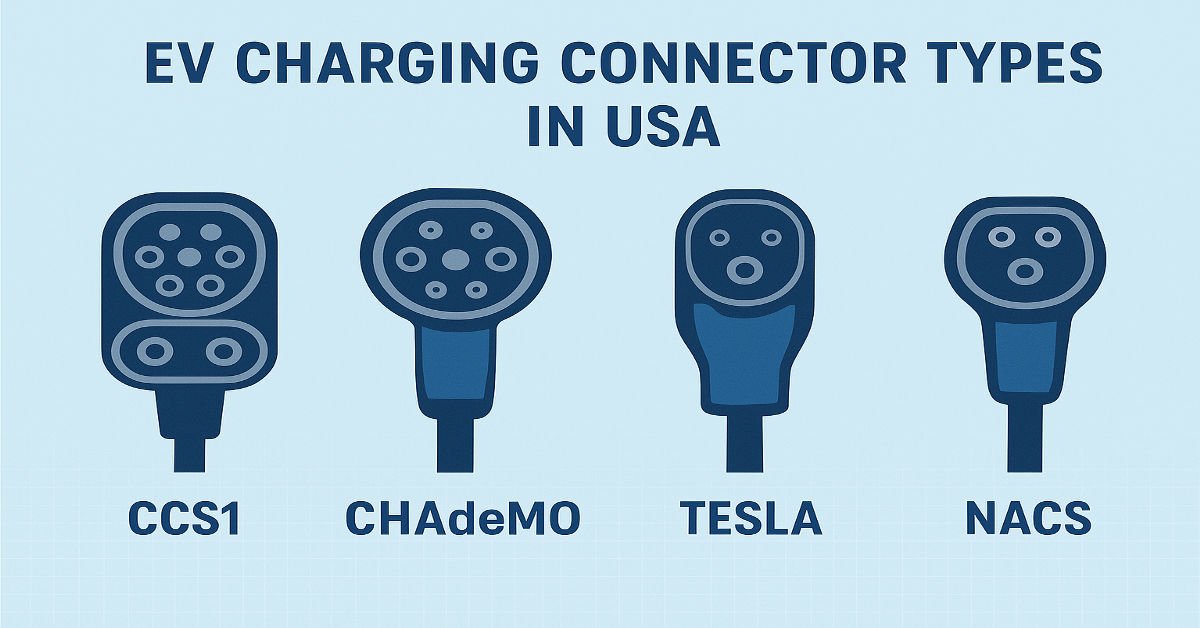Introduction
EV Charging Connector Types in the USA revolution in the United States is gaining remarkable momentum. From Tesla’s Supercharger network to public CCS fast chargers, knowing the different EV charging connector types is essential for every EV driver.
Each EV model supports a specific connector type, and understanding these variations ensures smooth, efficient, and safe charging—whether at home or on the go.
Overview of EV Charging Connector Standards in the USA
The U.S. market primarily uses five major EV charging connector types depending on the charging level and manufacturer.
| Connector Type | Charging Level | Common Vehicles | Max Power Output |
|---|---|---|---|
| J1772 (Type 1) | Level 1 & Level 2 | All non-Tesla EVs | Up to 19.2 kW |
| Tesla Connector (NACS) | Level 1, 2, & DC Fast | Tesla Models | Up to 250 kW |
| CCS Combo 1 (CCS1) | DC Fast Charging | Ford, GM, VW, Hyundai | Up to 350 kW |
| CHAdeMO | DC Fast Charging | Nissan Leaf, Kia Soul EV | Up to 100 kW |
| NEMA 14-50 / 5-15 | Level 1 Home Outlet | All EVs (with adapter) | 1.4 to 9.6 kW |
J1772 (Type 1) – The Universal Connector for Level 1 & 2 Charging
The SAE J1772 connector is the most common standard for AC charging across the U.S. It works with both Level 1 (120V) and Level 2 (240V) charging stations.
Key Features:
-
Compatible with nearly all EVs (except Teslas, which require an adapter).
-
Widely available in public charging networks like ChargePoint and Blink.
-
Ideal for home and workplace installations.
Charging Speed: 10–20 miles of range per hour depending on the EV and power source.
Tesla Connector (NACS) – America’s Fastest Growing Standard
Tesla’s North American Charging Standard (NACS) is known for its compact design and high efficiency. Initially exclusive to Tesla vehicles, it’s now being adopted by Ford, GM, Rivian, and others starting in 2025.
Advantages:
-
Sleek design with smaller pins.
-
Supports both AC and DC fast charging.
-
Access to over 25,000 Tesla Superchargers across North America.
| Feature | Tesla NACS |
|---|---|
| Connector Size | Compact and Lightweight |
| Charging Speed | Up to 250 kW |
| Compatibility | Tesla, Ford (2025+), GM (2025+), Rivian (2025+) |
CCS Combo 1 (Combined Charging System)
The CCS1 connector combines the J1772 AC plug with two additional DC pins for fast charging. It’s now the most common DC fast-charging standard among American and European automakers.
Compatible Brands: Ford, General Motors, Volkswagen, Hyundai, Kia, BMW, Mercedes-Benz, and more.
Benefits:
-
Dual-purpose connector for both AC and DC charging.
-
Supported by major charging networks like Electrify America, EVgo, and ChargePoint Express.
-
Delivers charging speeds of up to 350 kW on ultra-fast chargers.
CHAdeMO – The Japanese Legacy Connector
The CHAdeMO standard was developed by Japanese automakers like Nissan and Mitsubishi. It supports DC fast charging but has declined in popularity as CCS and NACS take over.
| Feature | CHAdeMO |
|---|---|
| Origin | Japan |
| Charging Speed | Up to 100 kW |
| Common Vehicles | Nissan Leaf, Kia Soul EV |
| Availability | Limited but still in use at some fast chargers |
Fun Fact: The term “CHAdeMO” comes from a Japanese phrase meaning “Charge for moving.”
NEMA 14-50 & 5-15 – Home Charging Connectors
Home charging often relies on standard wall outlets or NEMA 14-50 plugs. While these aren’t EV-specific connectors, they’re essential for Level 1 and Level 2 home charging setups.
Comparison Table:
| Plug Type | Voltage | Charging Level | Range per Hour |
|---|---|---|---|
| NEMA 5-15 (Standard Outlet) | 120V | Level 1 | 3–5 miles |
| NEMA 14-50 (Dryer Outlet) | 240V | Level 2 | 25–30 miles |
Future of EV Connectors in the USA: The NACS Adoption Trend
By 2025, most U.S. automakers are transitioning to Tesla’s NACS connector. The U.S. Department of Energy and SAE International have officially standardized NACS as the national charging standard, ensuring interoperability between networks and car brands.
Implications for Drivers:
-
Easier access to Tesla Superchargers.
-
Reduction in adapter requirements.
-
Improved cross-brand charging convenience.
Network Updates:
-
Electrify America, ChargePoint, and EVgo have announced plans to include NACS connectors in all new stations by late 2025.
Choosing the Right Connector for Your EV
When purchasing an EV or planning a road trip, understanding your connector type ensures you use compatible stations.
| Car Brand | Connector Type (2025) | Charging Network Compatibility |
|---|---|---|
| Tesla | NACS | Tesla Supercharger, Public NACS |
| Ford | CCS (Now shifting to NACS) | Electrify America, Tesla (adapter) |
| Nissan | CHAdeMO | Limited Networks |
| Hyundai/Kia | CCS | EVgo, Electrify America |
| Rivian | NACS (2025+) | Tesla Supercharger, Rivian Adventure Network |
Expert Tips for EV Owners
✅ Always carry a connector adapter, especially when traveling.
✅ Check the charging station compatibility before your trip using apps like PlugShare or ChargePoint.
✅ Prefer Level 2 home charging setups for daily use.
✅ Keep your EV software updated for connector compatibility and improved charging performance.
Conclusion
Understanding the different EV charging connector types in the USA is vital for a seamless EV ownership experience. With the shift toward Tesla’s NACS and increasing public charger accessibility, EV drivers will soon enjoy a standardized, faster, and more convenient charging network nationwide.
Whether you drive a Tesla Model 3, a Ford Mustang Mach-E, or a Nissan Leaf, the future of EV charging in the USA is bright, efficient, and unified.

1 thought on “EV Charging Connector Types in the USA: Complete Guide for EV Owners (2025)”